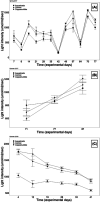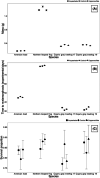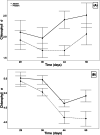Assessing the Impact of Chemical Algae Management Strategies on Anurans and Aquatic Communities
- PMID: 36342350
- PMCID: PMC10107480
- DOI: 10.1002/etc.5514
Assessing the Impact of Chemical Algae Management Strategies on Anurans and Aquatic Communities
Abstract
Pond management with chemical and biological agents that reduce overgrowth of algae is an important means of maintaining water quality in residential ponds, yet the effects on nontarget species are not fully understood. We assessed the impact of Aquashade (a common nontoxic pond dye) and copper sulfate (a toxic algaecide) on American toad (Anaxyrus americanus), northern leopard frog (Lithobates pipiens), and Cope's gray treefrog (Hyla chrysoscelis) metamorphosis in outdoor mesocosm experiments. We also evaluated the relative impact of tadpole grazing versus chemical treatment on phytoplankton and periphyton abundance. We found no significant effects of pond management treatment on anuran metamorphosis, suggesting that addition of Aquashade and copper sulfate at tested concentrations does not significantly impact anurans under these experimental conditions. Interestingly, we found that the presence of tadpoles more strongly reduced algal abundance than Aquashade or copper sulfate by significantly decreasing phytoplankton and periphyton abundance over time. The present study suggests that anuran tadpoles may be effective at maintaining water quality, and that Aquashade and copper sulfate may have minimal effects on amphibian metamorphosis. Environ Toxicol Chem 2023;42:213-224. © 2022 The Authors. Environmental Toxicology and Chemistry published by Wiley Periodicals LLC on behalf of SETAC.
Keywords: Aquashade; algae; amphibians; copper; management.
© 2022 The Authors. Environmental Toxicology and Chemistry published by Wiley Periodicals LLC on behalf of SETAC.
Figures




References
-
- Bartson, S. , Ogilvie, J. , Petroff, A. J. , Smith, G. R. , & Rettig, J. E. (2018). Effect of pond dye on the response of southern leopard frog tadpoles (Lithobates sphenocephalus) to western mosquitofish (Gambusia affinis) cues. Basic and Applied Herpetology, 32, 71–76.
-
- Batt, R. D. , Carpenter, S. R. , Cole, J. J. , Pace, M. L. , Johnson, R. A. , Kurtzweil, J. T. , & Wilkinson, G. M. (2015). Altered energy flow in the food web of an experimentally darkened lake. Ecosphere, 6, 1–23.
-
- Blaine, T. W. , Clayton, S. , Robbins, P. , & Grewal, P. S. (2012). Homeowner attitudes and practices towards residential landscape management in Ohio, USA. Environmental Management, 50, 257–271. - PubMed
-
- Boone, M. D. , & James, S. M. (2003). Interactions of an insecticide, herbicide, and natural stressors in amphibian community mesocosms. Ecological Applications, 13, 829–841.
-
- Brown, D. G. , Johnson, K. M. , Loveland, T. R. , & Theobald, D. M. (2005). Rural land‐use trends in the conterminous United States, 1950–2000. Ecological Applications, 15, 1851–1863.
Publication types
MeSH terms
Substances
Grants and funding
LinkOut - more resources
Full Text Sources

